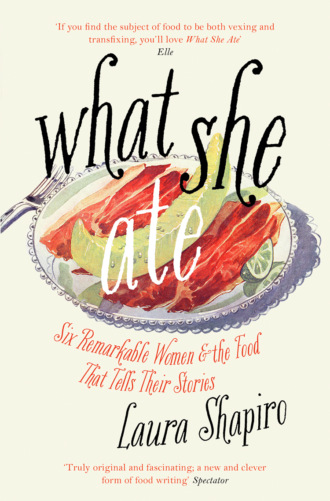
Полная версия
What She Ate: Six Remarkable Women and the Food That Tells Their Stories
Last we meet Helen Gurley Brown, the only woman here whose life extended into the twenty-first century. Helen’s relationship with food, like all her relationships, was dominated by men, or more precisely by what feminist art historians have called “the male gaze.” As the editor of Cosmopolitan she promoted full equality for women, but she did so in a spirit better exemplified by Playboy. Yes, women could be senators, stockbrokers, cabdrivers, and firefighters, but there was no higher calling for any woman than to attract a man. And Helen was adamant on how to attract men: it started with being thin. Rigorous self-denial at the table was the first of her ten commandments for women; in fact, it was all ten of them. The reward would be love and marriage, she promised, and she always displayed her own story as proof. Nevertheless, when she and David Brown were at home in the evening, they ate the way the Roosevelts did—separately.
Pursuing these women through their own writing, through their biographers, through the archives, pouncing on every clue that might help me figure out what they cooked or ate or thought about food, has been just the sort of research I love. It’s like standing in line at the supermarket and peering into the other carts, but with the rare privilege of complete freedom to pry. (Quinoa, miso soup, and four cans of tomato paste? What on earth are you making?) In the archives, happily, there’s no such thing as a rude question. Now that I’ve assembled each of these portraits, however, I can see that even though I’ve always worked within the facts, the facts alone are just the scaffolding. It’s the writer who comes up with the story. And I’m quite sure that none of these women would have written her food story the way I did. This became clear when I began assembling the epigraphs that appear at the top of each chapter. The idea was to introduce every woman with a meal that I found in the records of her life—a meal that summed up for me the complications inherent in her story. I can already hear the six of them objecting to my choices.
Dorothy is wondering a little nervously why I didn’t focus instead on one of those nice gooseberry tarts she used to make.
Rosa is demanding a rewrite: she wants an elegant French entrée that will assure her the place she deserves in gastronomic history.
Eleanor is lecturing me, patiently, on the progressive rationale behind her luncheon menu.
Eva is insulted that I’m describing her life in terms of food instead of, say, showcasing one of her handsome evening gowns.
Barbara, who loved finding out what people ate in real life, can’t imagine why I didn’t use one of her own recipes, especially since there were several among her papers.
Helen alone understands why I chose her particular meal, but she’s making it clear that a better writer would have recognized it as a triumph.
Ladies, I’m listening. What I’ve learned is that everyone’s a critic, even after death, and that any biographer who dares to think she’s getting the last word is sure to end up eating it.
Конец ознакомительного фрагмента.
Текст предоставлен ООО «ЛитРес».
Прочитайте эту книгу целиком, купив полную легальную версию на ЛитРес.
Безопасно оплатить книгу можно банковской картой Visa, MasterCard, Maestro, со счета мобильного телефона, с платежного терминала, в салоне МТС или Связной, через PayPal, WebMoney, Яндекс.Деньги, QIWI Кошелек, бонусными картами или другим удобным Вам способом.


